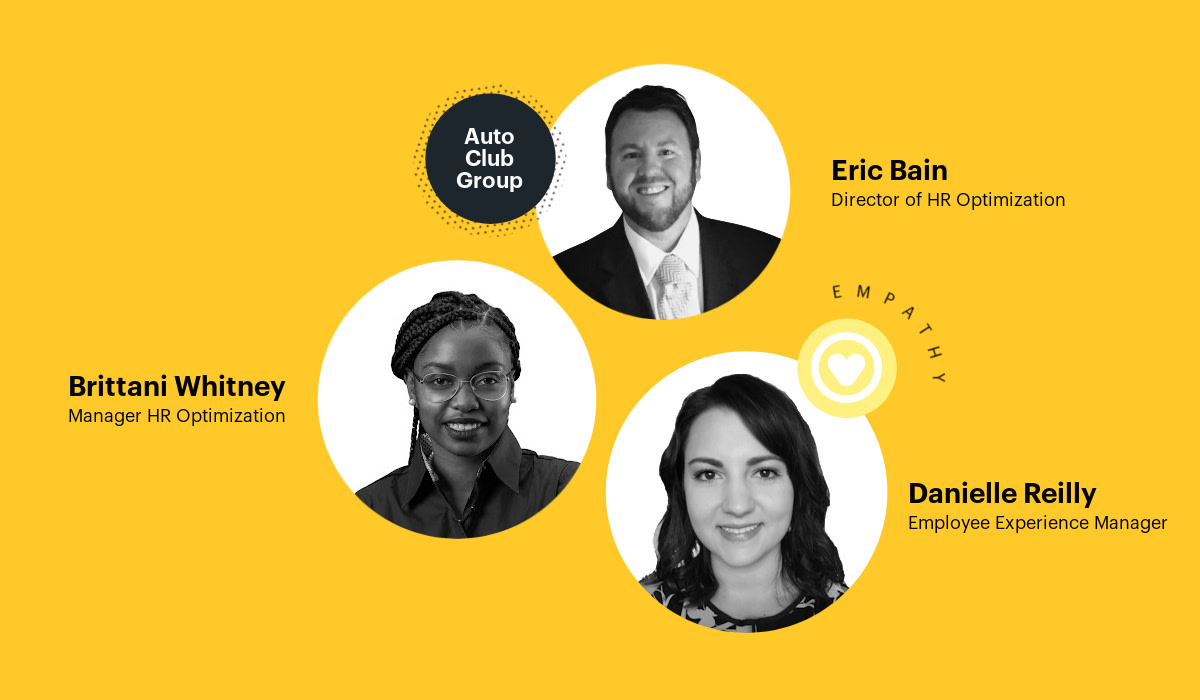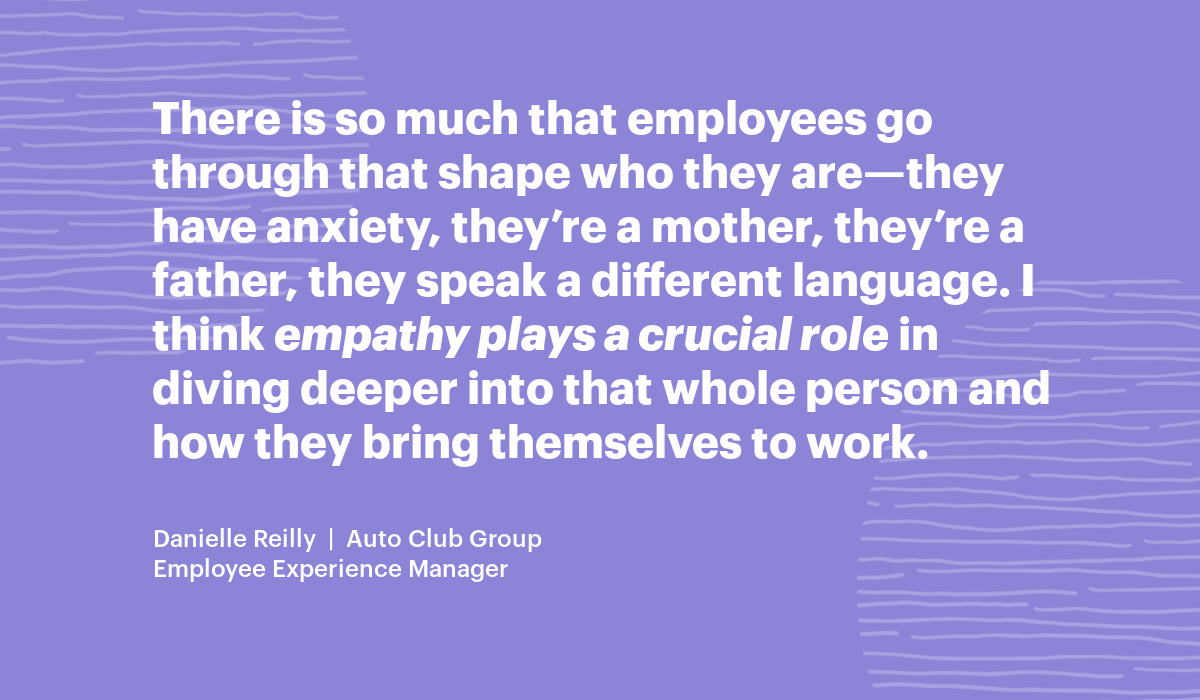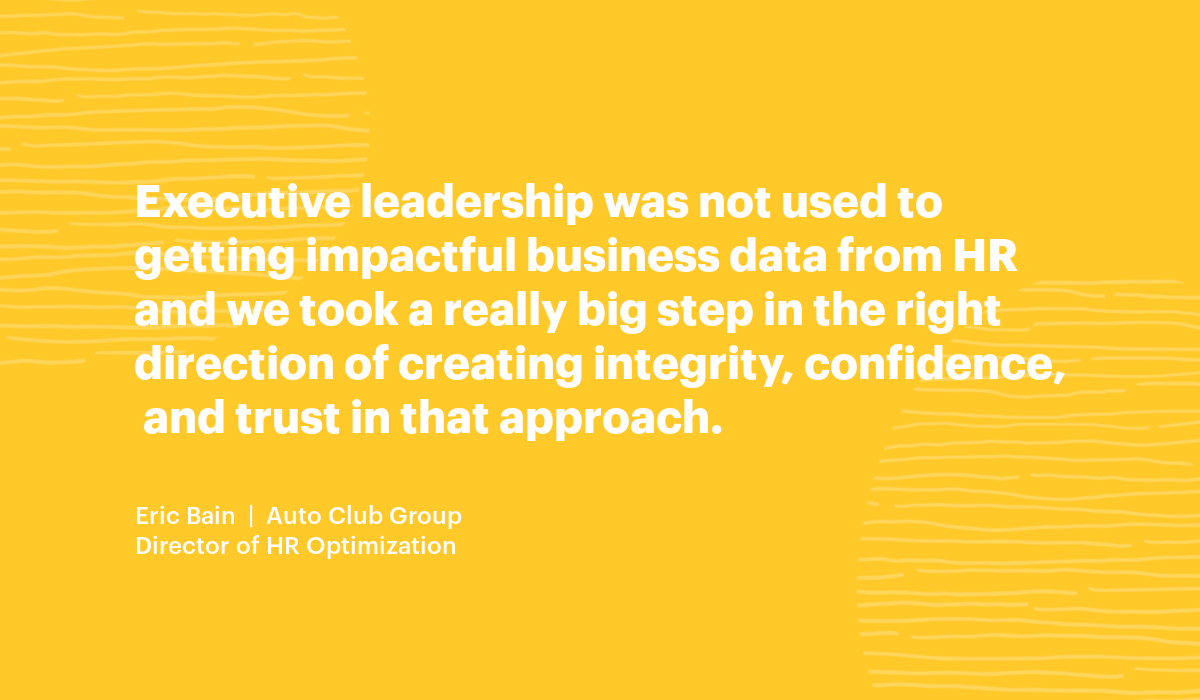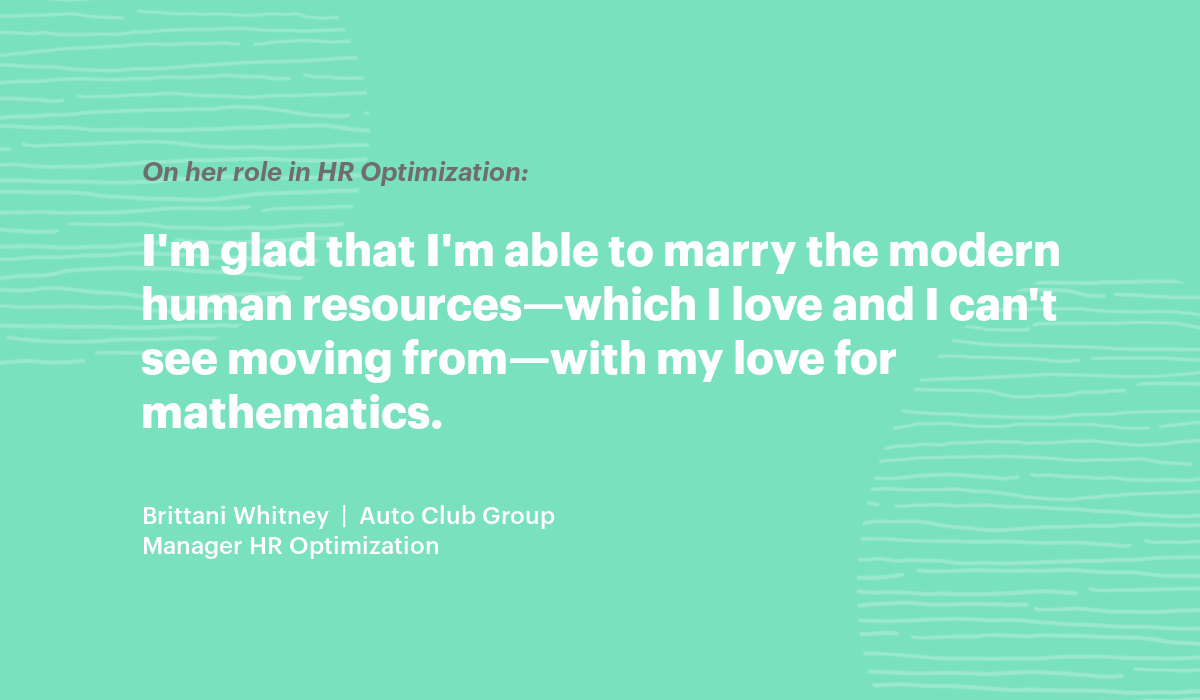Optimizing HR for Employee Experience with Brittani, Danielle, and Eric of the Auto Club Group
In this profile, we talk to three HR leaders at the Auto Club Group to learn how they're optimizing HR and expanding their work in employee experience.

The last 18 months proved that strong HR leadership is needed more than ever. In this profile series, we celebrate the HR Super Leaders that led their organizations through tough times by harnessing their HR superpowers—daring, vision, empathy, strategy, and connection—and proving that anything is possible when you put your people first. Learn more about these five superpowers and take our quiz to find out which one is yours!
When you need roadside assistance, travel help, or insurance for all life’s adventures, the Auto Club Group (ACG) has your back. And when ACG needs insights to better attract, retain, and develop their employees they turn to their HR Super Leaders: Eric Bain, Director of HR Optimization; Brittani Whitney, Manager HR Optimization; and Danielle Reilly, Employee Experience Manager. They spoke to us about the critical work they are doing to optimize HR and to expand their work in employee experience.
What does a typical day look like for you all?
Eric Bain: Our group is composed of four different components: data management and insights, project management, continuous improvement, and employee experience. We’re trying to use people data to help drive where The Auto Club Group (AAA) is going, from a people perspective, and which segments or roles we should prioritize while trying to create consumable insights on how to do those things and ultimately, lead projects to take us to the next level.
Danielle Reilly: I was recently promoted into this position and so I’ve been focusing on building up what that strategy looks like for our employee experience team. I’ve also been looking at the type of skill sets that will bring value to the organization when it comes to employee experience such as a change management specialist, an industrial organizational psychologist, and a program manager.
Brittani Whitney: For me, it’s continuing the training of Visier, as well as trying to figure out where we can take it next. It’s been about trying to understand how we can better align Visier to answer those questions for example, for those that are remote, as well as trying to get a better handle on our data governance. So day to day, I can never know, but it’s about being available to all of our users, as well as to our business lines, to help answer those business questions that help drive our organizational success.
Sounds like you’ve all got interesting backgrounds in this space! What led you to a career in HR and people analytics?
Danielle: I started off my career in talent acquisition and it’s funny, a lot of people who wind up in that career don’t ever have any interest in HR so it’s interesting that that’s where I started. It gave me a framework for interacting with people, understanding the diversity behind their experiences, and diving deep into their career.
Eric: I started with employee relations work. I was constantly tapped for figuring out how to better improve transactional processes and discover new ways to make it more strategic and aligned with our goals. The fundamental principles of really leading people from a data-driven perspective is what I found myself having in common with all of these projects. I like to understand how we’re doing in our current state and fundamentally improving the aspects of work that ultimately impact the way people do their job—as well as the way people feel about doing their job. That’s what I have a passion for.
Brittani: I actually started in mathematics—I was the type of introvert who didn’t want a position where I had to talk to people—but somehow I was led to the Auto Club Group, and within that I did several roles, from recruiting to benefits, where I had to talk to people and I had to be available for people. In one of my positions, I was the person they called when we lost an employee or a retiree. So being available for those families, you really had to have a human side of you and empathy to be available for them. Then, in early 2019, they brought up this optimization department and, me still missing my mathematics roots, I thought this would be the best fit. And I’m glad that I’m able to marry the modern human resources which I love and I can’t see moving from, and my love for mathematics finally.

How do you put the “people” in people analytics every day?
Brittani: In my area, we have many diverse backgrounds. We have a couple of people that are engineers, a couple of people in industrial psychology. Because of this, I try to give my team a little bit more background information so that they’re not quick to make decisions based on what the data is or what they assume data to be. Because it’s a bigger picture that’s always going on. We had pandemics within the pandemic so always trying to bring that up in our conversations so we don’t lose sight of that.
What do you mean by “pandemics within the pandemic?”
Brittani: I think of the movements within the different communities—like with me being African American and I have an Asian Pacific Islander on my team. So there were some things that we had to deal with entirely while we’re dealing with the pandemic, too. Those are things that I refer to as “pandemics inside a pandemic.”
Looking back at March 2020 to now, what’s a business challenge that arose because of that time? How did you address it?
Eric: We accomplished a lot in 2020 despite everything going on. We had integration activities with two AAA clubs, our Carolina group which was inclusive of two states, and we had a merger with Colorado which is another club. We went through auto insurance reform in the state of Michigan, which significantly impacted three of our major brands. In addition, we launched new insurance products while working through different business line transformations and leading a number of internal HR change initiatives—all while dealing with the pandemic, this quest for social justice, a number of hurricanes, a number of floods, a number of significant weather events and that all had a major impact on our world and our employees.
Despite those disruptions, our job is to support each and every employee at every stage of their lifecycle and, as you can see from all the things going on, we had to meet people in a lot of different places. We provided relevant consumable data and actionable insight that allowed leaders to not only ask insightful questions but ultimately solve the problems that were different in every area—and we got to do all that in real time.

It’s clear that employee experience (EX) is important at ACG. What did you do to keep EX at the forefront of your strategies over the last 18 months of chaos? How are you approaching EX going forward?
Eric: We introduced a survey tool called Medallia to launch different engagement, pulse, and ad hoc surveys. We were constantly touching base with employees on what they’re feeling, not only from the global pandemic perspective or the social injustice perspective but also, “How is your personal world interacting with your work world? What issues are you having?” We took that feedback and we got pretty good at funneling that information in and creating actionable insights and action plans based on it.
Danielle: One of the things that we’re looking to do now is a journey mapping of an employee by surveying them at every single stage. This will help us really determine how they feel about that moment. So, it could be they retired, it could be they got a promotion, they transferred to a new department, a manager change—and look at that through the lens of what that does to their engagement. My ultimate goal was to have some sort of heat map to see potential errors or risks occurring throughout the organization and determine ways to become predictive in how we address employee engagement. How can we reach out to that employee to re-engage them? So that’s really where I think Medallia and Visier will be really important for us to integrate the two systems and start to create predicative modeling.
I’m curious, with all of these divisions that you have—tow truck drivers, clubs in different states—can you talk a little bit about the different needs of each one that arose during this time that you were able to address?
Eric: Our emergency roadside crews did tremendous work supporting our members during the pandemic. The business lines did an excellent job communicating what we’re doing and why due to their member-facing responsibilities .
We faced entirely different challenges in our call centers and areas where we have brick-and-mortar stores, which we had to shut down, as well as the impact travel closures had on our travel agents with our travel agents once travel shut down. Questions our leadership asked then were: How are we keeping these roles busy? How are we retaining them? What can we do with these roles when they can’t sell what they’re trained to sell and can we utilize those skill sets in different places? What type of job rotation can we utilize for a short period of time? How do we keep them safe?
We looked at many different data points and it was unique for every group. We had to have a different communication style, a different strategy, and a different feeling of what we were doing and why we were doing it for all our business lines. And our department—HR optimization—and Visier helps significantly in all of that. We would run queries before and have to sort and send it out and try to figure out who was in what building or what city, we didn’t have to do any of that here. We were able to do this very quickly, effectively, and succinctly in real time.

How is ACG approaching the return-to-work conversations?
Danielle: Fortunately, our CEO is very flexible in hearing from our employees and getting feedback from them on what they prefer. So, one of the initiatives that we recently rolled out was this hybrid flex work program where we’re giving certain groups the opportunity to opt in if they do want to return to the office one or three days a week.
It’s just a pilot program right now. We have almost 300 people who opted in to participate and we’ve been surveying them every couple of weeks just to see what it’s like. Has it met your expectations? Is there anything we can be doing differently? So, I’m really fortunate that we’re actually taking that approach of getting feedback from employees and then acting upon that to make their experience better.
What’s your advice for building a data-driven culture like what you have at ACG?
Eric: Our biggest challenge was presenting things that are not just basic data points—as in, you’re not just a female, you’re not just living in this state, you’re not just in this department. We have to look at the whole person. We’ve got to look at experience, sentiment, voice, how employees are feeling about things like work, productivity, workload, balance, and what’s happening at home.
We’re trying to take all that information and tell a compelling story to make change and that is our biggest hurdle. Executive leadership was not used to getting impactful business data from HR and we took a really big step in the right direction of creating integrity, confidence, and trust in that approach.
Lastly, Visier imagined five HR superpowers that guided leaders through the storm of upheavals. What are your superpowers and what do they mean to you?
All: Empathy!
Danielle: If you think about the glacier image that we see in DEI, you see everything on the surface-level. And now we’re trying to look deeper, beneath the surface: What is there about that employee? There is so much that employees go through that shape who they are—they have anxiety, they’re a mother, they’re a father, they speak a different language. I think empathy plays a crucial role in diving deeper into that whole person and how they bring themselves to work.
Eric: There has to be a differentiating factor of why you stay with an organization and HR is the driver of bringing it back to that people perspective. How meaningful is the work? How strong is the management connection that I have? Do they care about me as a person? Do I have trust in the strategic direction we’re heading? All of those things have to be led with empathy.
Brittani: You have to look at the human side and think about those things you don’t see on paper—like those who became mothers during the pandemic—you don’t see that someone had a birth; we don’t pull that data. It’s trying to always remember that information can also contribute to the data that you don’t see. That’s something that I will take with me in all positions I have going forward.
Meet the rest of our HR Super Leaders and find out your HR superpower.


